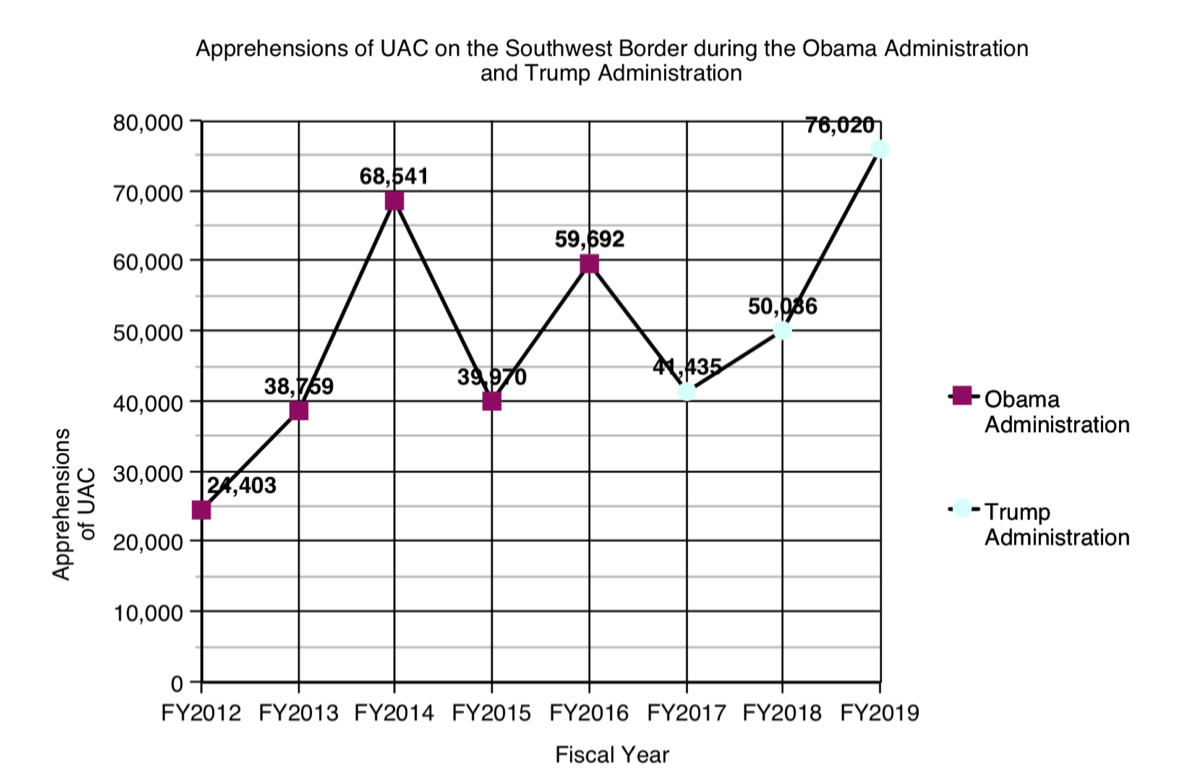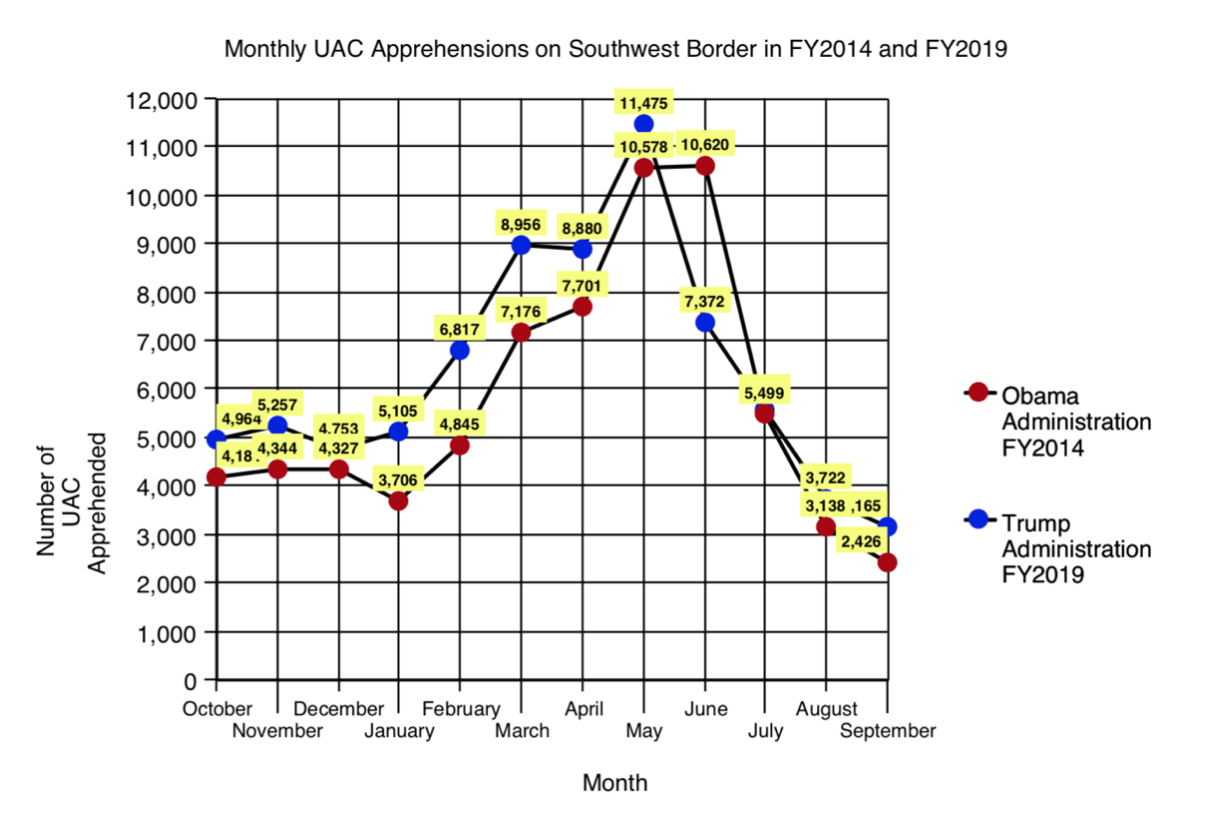Ruta de navegación
Blogs
Entries with label us southwest border .
The avalanche of unaccompanied foreign minors suffered by the Obama administration in 2014 has been overcome in 2019 by a new immigration peak
In the summer of 2014, the United States suffered a migration crisis due to an unexpected increase in the number of unaccompanied foreign minors, mostly Central Americans, who arrived at its border with Mexico. What has happened since then? Although oscillating, the volume of this type of immigration fell, but in 2019 a new record has been registered in the wake of the recent "caravan crisis", which has increased again total apprehensions on the border.
![US Customs and Border Protection agents processing unaccompanied children, in Texas, at the border with Mexico, in 2014 [Hector Silva, USCBP-Wikimedia Commons]. US Customs and Border Protection agents processing unaccompanied children, in Texas, at the border with Mexico, in 2014 [Hector Silva, USCBP-Wikimedia Commons].](/documents/10174/16849987/migracion-blog.jpg)
▲ US Customs and Border Protection agents processing unaccompanied children, in Texas, at the border with Mexico, in 2014 [Hector Silva, USCBP-Wikimedia Commons].
ARTICLE / Marcelina Kropiwnicka [English version] [Spanishversion].
The United States hosts more immigrants than any other country in the world, with more than one million people arriving every year either as permanent legal residents, asylum-seekers and refugees, or in other immigration categories. While there is no official measure of tracking how many people successfully cross the border illegally, US Customs and Border Protection (CBP) authorities measure the changes in illicit immigration using the amount of apprehensions per fiscal year; apprehensions being an indicator of total attempts to cross the border illegally. Looking at data, it can be concluded that there have been B changes in the demographics of illegal migration on the southwest border with Mexico (or Southwest border) over the last few years.
The soaring peak of apprehensions on the Southwest border was in 2000 when 1.64 million persons were detained for trying to enter the US illegally. The figures have generally declined since. Interestingly enough, in recent years, there have been more overall seizures of non-Mexicans than Mexicans at US borders, reflecting a decline in the number of unauthorized Mexican immigrants coming to the US over the past decade. The surge, in fact, was largely due to those fleeing violence, gang activity and poverty in Guatemala, Honduras and El Salvador, known collectively as the Northern Triangle.
The nations included in the Northern Triangle are among the poorest in Latin America-a high percentage of the population still lives on less than $2 a day (the international poverty line is $1.90)-with minimal advancement occurring to reduce poverty in recent years. Within Latin America and the Caribbean, Honduras has the second-highest share with 17% of the population living below the international poverty line, after Haiti, according to the latest data from the World Bank.
Unaccompanied Alien Children
Far fewer single adults have been attempting to cross the border without authorization over the past decade, and a surge of unaccompanied alien children (UAC) crossing the Southwest border occurred. The migration of minors without an adult is not new; the novelty today is the size of this migration and the generation of policies in response to the issue. The spike of UAC apprehensions in FY2014 caused alarm and prompted average scrutiny and policy responses, and attention remained even as the number decreased; numbers dropped back down to just under 40,000 UAC apprehensions the following year.
The international community defines an unaccompanied migrant child as a person, "who is under the age of eighteen" and who is "separated from both parents and is not being cared for by an adult who by law or custom has responsibility to do so" (UNHCR 1997). Many of these unaccompanied children immediately present themselves to US-border security whereas others enter the US unnoticed and undocumented. Not only this, the children have no parent or legal guardian available to provide care or physical custody which swiftly overwhelms local border patrols.
In 2014, many of the unaccompanied children claimed they were under the false impression that the Obama Administration was granting "permits" to children who had family members in the US, as long as they arrived by June. These false claims and "sales pitches" have become more potent this past year, especially when President Trump continues to reinforce the idea of restricting migrant access to the US. Cartels have continued transporting soaring numbers of Central American migrants from their countries to the United States.
Critical moments of 2014 and 2019
During Obama's second term, in FY2014, total apprehensions along the Southwest border reached the number of 569,237 (the figure includes "inadmissibles"), a record only surpassed now. The apprehensions soared 13% compared to FY2013, but the main increase was for UAC seizures, which surged immensely from 38,759 in FY2013 to 68,541 in FY2014, a nearly 80% increase, as well as more than four times as many UAC as in FY2011. In a year, the figure of minors from Honduras increased from 6,747 to 18,244; minors from Guatemala rose from 8,068 to 17,057, and those from El Salvador, from 5,990 to 16,404 (minors from Mexico, on the other hand, dropped from 17,240 to 15,634). Apprehensions were highest along the Southwest border in the month of May, where 17% was made up by UAC seizures.
Since FY2014, UAC apprehensions have fluctuated considerably. In FY2019, however, apprehensions of UAC reached 76,020, a level that now exceeds the peak reached in FY2014. The maximum level was registered in May; however, that month they accounted for only 9% of total apprehensions, because this time it was not properly a UAC crisis, but a remarkable peak of total apprehensions. Although overall apprehensions decreased significantly during the first six months of Trump's tenure, they rose alarmingly in FY2019, reaching a total of 851,508 (977,509 if the "inadmissibles" are added). Current data shows that seizures along the Southwest border have more than doubled from the previous FY2018. The number of overall apprehensions increased by 72% from FY2014 to FY2019 (in the case of UAC increased 11%).
 |
 |
Apprehensions of Unaccompanied Alien Children on the US-Mexico border, between 2012 and 2019 (figure 1), and comparison between 2014 and 2019 by month (figure 2). Source: US Customs and Border Patrol.
US Policies
The US had established numerous domestic policies which dealt with the massive rise in immigration. With the overwhelming peak in 2014, however, Obama requested funding for "the repatriation and reintegration of migrants to countries in Central America and to address the root causes of migration from these countries". Though funding was fairly consistent the past years for the program, the budget for FY2018 proposed by President Trump would cut aid to these countries by approximately 30%.
While Trump's administration has made B progress in its immigration diary, from beginning the construction of the wall to enforcing new programs, the hardline policies that were promised before inauguration have thus far been unsuccessful in stopping thousands of Central American families from trekking across the Southern Border into the US. With extreme gang violence being rampant and the existence of "loopholes" in the US immigration system, the pull-factor for migrants will remain.
